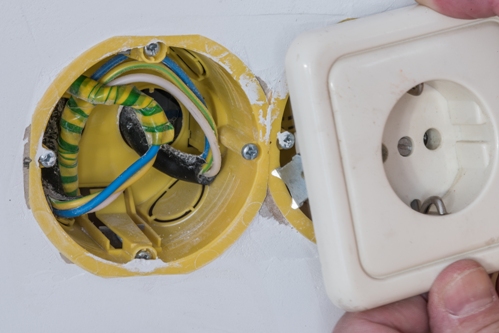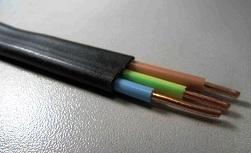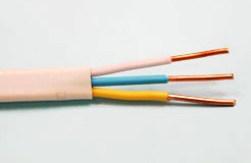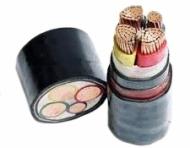Categories: Featured Articles » Electrician at home
Number of views: 753470
Comments on the article: 26
Which wires and cables are best used in home wiring
Currently, for the installation of home electrical wiring, wires and cables exclusively with copper conductors are used. Wires and cables with aluminum conductors for internal wiring not allowed.
Wires and cables are single-core and multi-core. Stranded wires and cables have in their common sheath two or more wires that are reliably isolated from each other.

Example stranded wire – PRTO brand wire (wire with a copper core with rubber insulation, braided from cotton yarnsoaked with antiseptic composition).
Conductors of single-core and multicore wires and cables can be made single-wire and multi-wire.
Cables and wires differ from each other by the type of sheath and names. The sheath of wires and cables serves to protect the insulation of the cores from exposure to light, moisture, various chemicals and prevent them from mechanical damage. The cable may include armor, and the sheath allows them to be laid in more adverse environmental conditions.
Wires can only be laid in a hidden way, with open gasket - only in pipes and boxes. Cables can be routed openly.
The most popular cable for use in home wiring is VVGng, less commonly used cable NYM and PUNP wire.
It is best to use a NYM cable to connect to the floor shield. The same cable is used to connect the floor shield to the apartment or room shields (provided that such are available). Usually such guards are organized in private cottages. It can also be used to individually connect powerful consumers. This cable can do the whole power wiring in an apartment or house, but since it costs more than VVGNG cable and PUNP wire, it is used less often for these purposes.
VVG - unarmoured protected cable with copper conductors, polyvinyl chloride insulation, polyvinyl chloride sheath. The cable can be used in dry and wet rooms.
The VVG cable is not designed for tension. The insulated conductors of the VVG cable are twisted and have a distinctive color. The inner shell does not contain filling in the inter-core space.

Fig. 1. VVGng cable
ABOUTThe designation "ng" in the name of the cable (VVGNG) means that it does not spread combustion when laying in bundles (a composition based on refractory plastic compound is used). If the VVG cable is used instead of the VVGng cable, then in the event of the ignition of one of the cables, the flame will spread to the other cables, instead of localizing the source of the fire.
VVGng cable has a wide variety of shapes. It is most convenient to use a flat cable VVGNG. In addition, it is also round, square, sector, and even triangular.
NUM cable (NYM) - produced according to German standard DIN 57250. The cable can be used indoors with hidden and open installation. Cable NYM can be used in air, only outside direct sunlight. Cable NYM It has a reduced combustibility and gas emission, which is especially important for residential premises.

Figure 2. Cable NYM
Cable NYM consists of copper conductors, an intermediate shell made of finely filled rubber and a shell made of unsupported combustion of polyvinyl chloride insulation. The use of an intermediate sheath in the cable design makes it easy and convenient to cut the cable during installation, increases its fire hazard and increases flexibility.
PUNP - installation flat wire. This is the cheapest wire of all cable and wire products used for wiring in the home.The PUNP wire is available with two or three copper single-wire conductors and polyvinyl chloride insulation in a sheath of PVC compound. Cores can be painted in different colors.

Fig. 3. PUNP wire
PUNP wire is available only flat. These cable and conductor products are used for both power and lighting networks. In the second case, wires of smaller cross sections are taken.
I do not recommend using the PUNP wire when laying home electrical wiring, since the insulation of this wire is made of cheap materials and very quickly loses its properties when heated. When choosing a cable for wiring, give preference to cables of brands VVGng or NYM.
Much less commonly used in home wiring are wires with rubber insulation of the PRN, PRI, PRTO brands. The PRTO wire is intended for laying in fireproof pipes, PRI can be used for laying in dry and damp rooms, PRN (protected wire) - in the open air, PRD, PRVD (twisted-wire twisted wire) - only in lighting networks of dry rooms.
For open wiring, it is convenient to use a flat wire with copper conductors and PVC insulation with a separation base of the PPV brand, as well as a wire with polyethylene insulation PPP. There is a flat wire without a dividing base - PPVS, but it is not very convenient to use it.
Previously used wires with aluminum conductors (АПР, АПВ, АПРТО, АППВ) are not used now in the construction and modernization of home electrical wiring.
Wire with copper conductor and PVC insulation PV. PV wires can be single-wire and multi-wire. The wires are available in different colors of insulation. In household electrical wiring aboutPV1 core wire in yellow-green coloring is used for systemss equalization of potentials (ДСУП).

Fig. 4. Wire PV1
The wires PV2, PV3 and PV4 are used for indoor installation in electrical panels. The wirea PV3 and PV4 are usually more expensivebecause have a more flexible shell. They are used where bends of wires are needed.
To power street lights, trenching used underground armored cable VBBSHV, or cable with aluminum conductors AVBBSHV. This cable is protected by a steel tape under a layer of PVC insulation.

Fig. 5. Cable VBBSHV
VBbShv cable is available with three, four and five conductive cores. Previously, cables with copper conductors in the polyvinyl chloride sheath of VRG and armored cables with aluminum conductors of the AAShv, AAB, AVVB and AVRB brands were used for these purposes.
For air branches, in our time the most popular self-supporting insulated cable (SIP). There are a large number of varieties of such a cable: SIP-2A, SIP-3, SIP-4. The cable has wires of steel-aluminum wires of great strength. The cores are insulated with special light-stabilized weather-resistant polyethylene, which does not break down in the open air.
Earlier for air branches AVVG cables with ordinary polyvinyl chloride insulation were widely used, which, under the influence of adverse environmental factors, quickly became fragile and collapsed. The use of a self-supporting insulated SIP cable solves this problem.
When choosing wires and cables must be observed PUE requirements for insulation painting.
The insulation of the zero working conductor should be blue, zero protective - yellow-green. The color of the insulation of the phase conductors must differ from the color of the zero. There are many options - brown, red, gray, white, black, etc.
Fig. 6. Coloring options for wires and cables
It is also very convenient to use for each section of the wiring its own color of the phase conductors, as well as different colors of the insulation of conductors for power and lighting wiring.
If you choose and then install the wiring with a wire or cable without observing the requirements for the color of the wires, then in the future, this will lead to significant difficulties in the maintenance and repair of such wiring, and the installation process itself can be very complicated, especially when using a large number of switches and sockets. In addition, the use of wires and cables with insulation of the same color is a violation of the PUE.
See also: Color marking of wires and cables
See also at i.electricianexp.com
:

